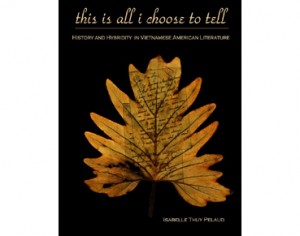As a co-managing editor, I am fortunate to have deep exposure to amazing ideas and visions and critiques via this blog—so it’s difficult to narrow anything of value down to ten, around here. However, in no particular order, I’ve selected ten of my all-time favorite diaCRITICS posts, for your enjoyment and re-appreciation.
—
dao strom’s the war after the war post really hit home for me, on a variety of levels—ghosts, writing, art, mixed-race identity, war, ‘concentric rings rippling out’ in the aftermath of war, the nods of recognition between those with affiliation/connection to Việt Nam. I found myself wishing I’d known the author when I lived in Portland, if she’d lived there during my six-year residency—I felt such a deep sense of familiarity with her reflections and experiences.

Viet Nguyen’s discussion of Isabelle Thuy Pelaud’s book release reminds us all to pursue our work no matter how ‘marginal’ or ‘irrelevant’ our scholarship seems to be, at first, to disinterested observers. This book breaks ground in the field of Vietnamese American literature, contributing to its advancement in fundamental and dynamic ways. I loved Viet’s personal touches and recollections of Isabelle from grad school days. More importantly, I can’t wait to get my hands on a copy of this is all i choose to tell: history and hybridity in Vietnamese American Literature, at DVAN’s fundraiser in January.
These exquisite photographs by Jamie Maxtone-Graham tell stories of real people, with their melancholia, tensions, and apprehensions. There are simultaneous romantic and anti-romantic qualities which I love. The lighting is luscious and the composition is dynamic and engaging. I am so excited by his portraiture!
Khanh Ho’s Notes on Exile is poetic, philosophical, political, and pedagogical. It echoes my purchase of an anthology on exiled writers, which I bought 13 years ago at Powells Books in Portland, as I was looking sidelong for insights into the refugee experience. Seems that exile has a romanticism that’s missing from the refugee—and this post meditates (with some strong wit) as to why. And this line in brilliant: “This was entirely their fault: none of them wore the proper accessories.”
Bao Phi’s essay on a decade of Asian Am spoken word reminded me of discovering a favorite magazine. You wanna steal it from the doctor’s office because you’re not sure where you can find it on the newsstand, and it opens you up to another world of recognition, and to other languages. Watching the clips of his spoken word, in this post, also blew my mind. I’d heard him speak before, in San Francisco, and I happily sent this post to many friends who’d appreciate his humor and insight.
Missing Việt Lê’s boy bang/ gang band exhibit made me so mad that I wasn’t still living on Sihanouk Boulevard, on the same block as Java Gallery in Phnom Penh, as I was in June and July of this year. Việt’s documented enactments of boy bands are brilliantly saturated in the sense of deep play and engaged political, sexual, and cultural aesthetics that I’ve come to know and love in Việt’s work. Um, hot and compelling. What’s not to love?
Cam Vu’s post on Tam Tran’s engaged life, and tragic passing, resonated deeply. Many Vietnamese Americans are detached from the debates about ‘illegality’ in the U.S., attributing the ‘problem’ to those emigrating by land from the south. Tam’s activism around the Dream Act, and her passionate pursuit of political and social justice, is worth everyone’s attention and compassion. I mourned when the Dream Act failed to pass recently, as I mourned Tam’s death when I learned of it. She will never be forgotten by those of us whose lives she touched.
As an Amerasian who was born on U.S. soil, I have a strong affinity for those who weren’t quite so lucky. Yet how much, truly, has separated our lives? What twists of fate differentiate my experiences from Amerasians born in Việt Nam? This interview with Tammy Nguyen Lee, director of Operation Babylift, draws attention to these sometimes-forgotten ‘by-products’ of the American war, and this sometimes-forgotten episode in the history of the Fall of Sài Gòn.
I saw this exhibit by Dinh Q. Le at TransPOP: Korea Vietnam Remix (in San Francisco) and it completely astounded me. It also expanded my sense of how helicopters have prominently figured into my inherited memories of war, as the daughter of a Cham-French Vietnamese refugee who escaped by helicopter, and as the step-daughter of a US Army combat helicopter pilot. I would love to see this exhibit at MOMA—and I am grateful to see good critical attention drawn to the MOMA exhibit.
I love Nguyễn Quí Đức’s Loudspeakers in different languages partly because it addresses some of the frictions between Vietnamese American and Vietnamese identities and memories of war. Yet, at the same time, as lê thị diễm thúy writes, Vietnam is not a war. So I particularly appreciated this passage in the post: “I explained to my local friends that we artists in the diaspora have a dual role. We have to keep the memory alive, while speaking to another audience who doesn’t seem to get that Vietnam is a country, a nation, a culture, a people.”
– Julie Thi Underhill, managing editor of diaCRITICS
Did you like these posts? Then please take the time to rate them and share them. Ratings for top posts are listed on the sidebar. Sharing (on email, Facebook, etc.) helps spread the word about diaCRITICS. Thanks!


